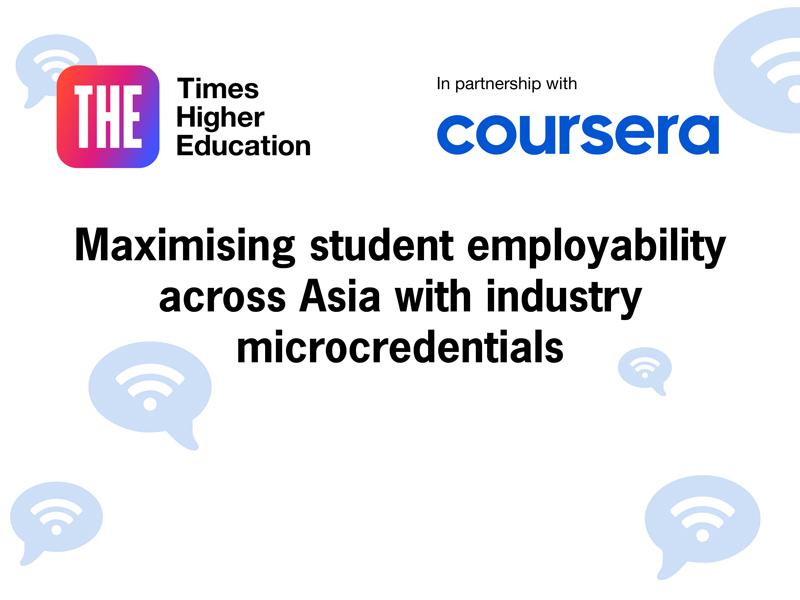
Introducing microcredentials: a guide for educators and students
As we enter an era of big skills gaps and an equally sizeable urgency for developing said skills and competencies, microcredentials are becoming increasingly relevant and common. I was inspired to put my thoughts together on this topic after attending a great international panel session on microcredentials and networking at Times Higher Education’s event Digital Universities Asia 2023, held earlier this year in Kuala Lumpur.
Questions worth considering include: what are microcredentials? How do we design a microcredential so that it is really worth learners’ time, rather than randomly package some learning outcomes together? How small/bite-sized should a microcredential be?
- An introduction to microlearning
- Resource collection: The business of online education
- THE podcast: the big ideas behind microcredentials
Microcredentials can be described as mini qualifications or credentials that demonstrate skills, knowledge and/or experience in a particular area. From our perspective at Singapore Institute of Technology, we design every microcredential for learners to gain certain competencies that are demonstrable and related to job functions. In this article, we will share considerations from both an educator’s and a learner’s perspective when designing and choosing microcredentials.
Relevance
Educator’s consideration: A microcredential is a certification of specific skills and knowledge, often obtained through a short-term, focused learning programme. It is the learning provider’s responsibility to put together content that is relevant to certain job functions and to design relevant assessments that allow learners to demonstrate the skills and knowledge that are in demand in the job market.
Instead of rushing into packaging some contents that lead to few learning outcomes and calling it a microcredential, time and effort must be committed to understand the job demand, the skills gap and what things are most important for learners to pick up.
Learner’s consideration: Consider your career goals. How are the new skills and knowledge applicable to your job or a job function that you are aiming for?
Flexibility
Educator’s consideration: Much of the beauty of a microcredential is its flexibility for busy learners to pick things up at their own pace and space. This means that learners do not have to disrupt their career or pause it to learn new skills. Online and self-paced options can provide learners with greater flexibility in completing the programme; however, ensuring that there is a mechanism to encourage pacing and completion is important. Educators need to carefully consider instructional design for a learner-centric experience that enables optimal flow, pace and achievement of outcomes.
While online and self-paced learning is more straightforward for straight knowledge acquisition, one should not neglect the importance of hands-on skills that might require demonstration and practice. Building in some synchronous lessons or even in-person/physical learning and assessments might be necessary. Educational technology has advanced, enabling simulations and online demonstrations of skills to be possible, so while designing for flexible, self-paced learning, consider how hands-on, practical elements can also take place in a seamless way.
Learner’s consideration: Is there a good balance between flexibility and demand for task completion? If the learning is designed to occur mainly online, are there opportunities for you to pick up hands-on, practical skills that you will need to demonstrate at work?
Recognition
Educator’s consideration: A microcredential should provide tangible recognition of the learner’s achievement, such as a digital badge, certificate or transcript. For a learning provider such as a university, careful deliberation should be in place to assess what the learning is worth. Universities can thoughtfully collaborate with organisations in upskilling their staff, providing some incentives for completion of microcredentials and thus encouraging their employees to keep learning, signalling that the employer values the time and effort committed to gaining new skills.
Depending on organisations, incentives that recognise completion of microcredentials might include a small pay rise, extra days off or the opportunity to enter a new and exciting job function. Alternatively, universities can also work with organisations to promote skills-based hiring, where new job openings are opened to learners who have completed certain microcredentials that ensure assessments of skills through performance. Ideally, we should aspire towards offering microcredentials that are recognised not only as academic credentials but also as professional credentials by industry and professional bodies.
Learner’s consideration: How do you ensure that the microcredential you choose to complete can be recognised? Can you proactively apply it to your job role and communicate with your employer on translating your learning into your role? Can you find new job opportunities within or outside your organisation to apply the new skills that you have gained?
Sizing
Educator’s consideration: While it is tempting to offer contents that are bite-sized and can be completed within a very short period, universities should be cautious of running a race to the bottom and thus diluting the value of microcredentials. Do we really think that one can gain significant competencies related to job functions from a two-hour online course or a one-day workshop?
The fundamental question on sizing of a microcredential in term of credits or duration is not about seat time or how many contact hours of learning content. Instead of measuring seat time, focus on learning. It is the significance of the competencies that showcase the value of the learning undertaken and its potential impact on business operations.
Learner’s consideration: “You reap what you sow.” Instead of looking around for the shortest microcredentials that are being offered and collecting many different certificates, focus on picking the ones that are serious in helping you gain significant competencies. Rather than looking for those that offer ease of completion and simple assessments, consider a microcredential that enables you to practise and be assessed on demonstrable competencies that will make a real difference to your job function and career aspirations.
By taking these considerations into account, both educators and learners can ensure that microcredentials provide meaningful value, relevance and recognition in the rapidly evolving world of skills development.
May Lim is assistant provost (applied learning) at the Singapore Institute of Technology.
If you would like advice and insight from academics and university staff delivered direct to your inbox each week, sign up for the Campus newsletter.




